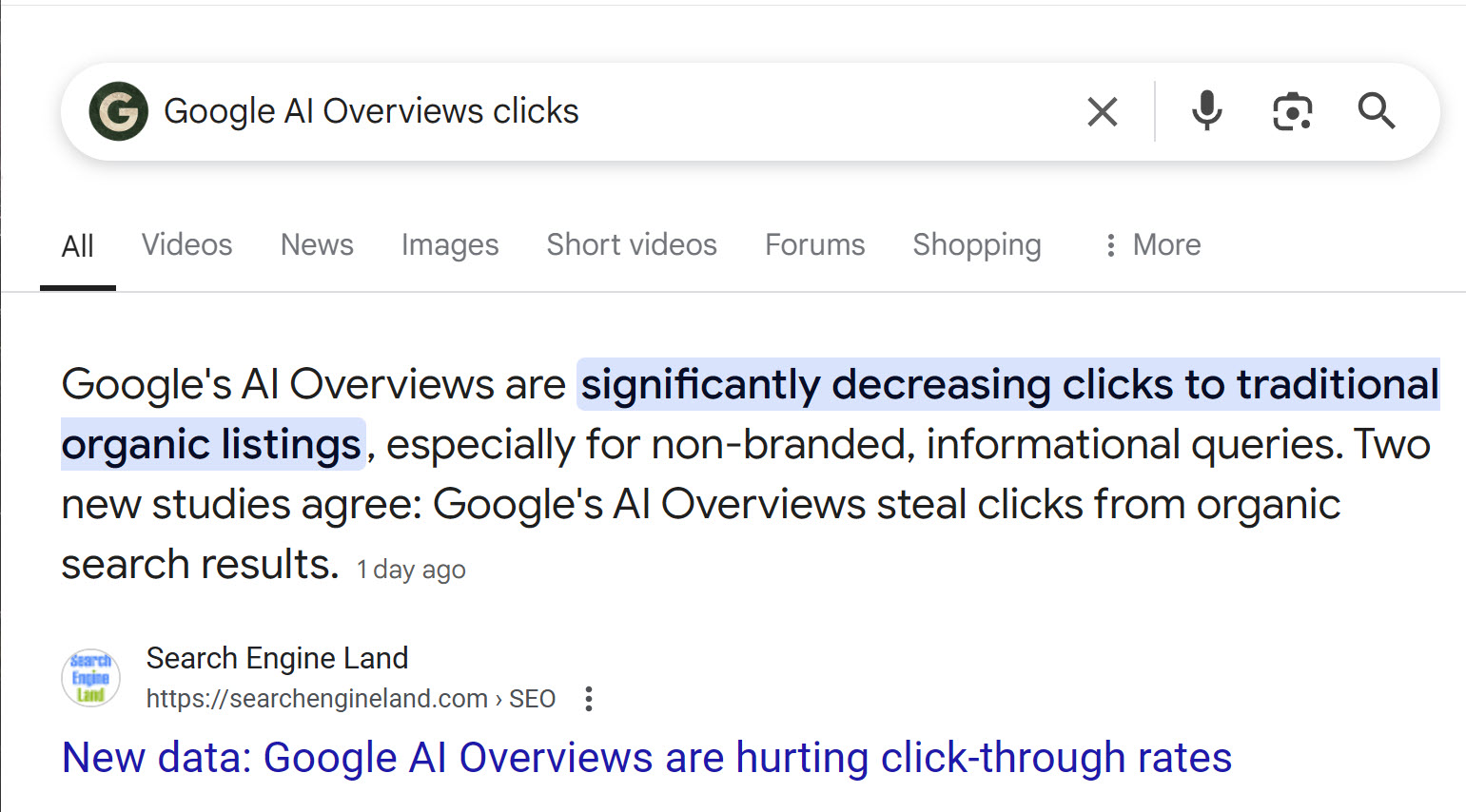
Google AI Overviews and the New Search Reality: What Marketing Leaders Need to Know (2025)
Why this matters now
In just one year, Google’s AI Overviews (AIO)—the multi‑sentence, AI‑generated summaries that sit above the familiar “blue links”—have gone from limited pilot to a core element of mainstream Search. As AIOs roll out globally, many publishers report traffic declines, even as Google insists that “higher‑quality clicks” are flowing to sites that do earn a tap. For CMOs and senior marketers, understanding the new rules of engagement is no longer optional; it is a board‑level issue affecting reach, media budgets and measurement.
Are organic clicks really disappearing?
A look at the data…
| Study | Scope | Findings |
| MOZ (2025) | 46,000 keywords | Organic traffic could fall 18% to 64%, especially informational sites. |
| Semrush (2025) | 10M+ keywords | 13.14% of all queries triggered AI Overviews in March 2025, up from 6.49% in January 2025. |
| Ahrefs (Apr 2025) | 300 k informational keywords | The presence of an AIO cut position‑one CTR by 34.5 %. |
| Search Engine Land (Feb 2025) | ~10 000 keywords | Organic CTR on AIO queries slid from 1.41 % to 0.64 % YoY; paid CTR fell across the board. |
The consensus is clear: overall click volume is shrinking, especially for mid‑funnel, non‑branded searches.
Google’s counter‑narrative: “higher‑quality” clicks
Elizabeth Reid, Google’s Head of Search, argues that when users do click, they bounce less and engage longer, describing these visits as “higher quality.” She points to deeper scroll behavior and a broader diversity of cited sources.
Meanwhile, Apple claims that search volume on Google from Safari has declined for the first time in two decades due to AI. Google counters that “We continue to see overall query growth in Search.” That includes an increase in total queries coming from Apple’s devices and platforms.” The complexities of both sides of the argument were recently cited in Fortune.
• Fewer sessions, higher intent. Traditional volume‑driven KPIs (sessions, % new users) will look worse; downstream metrics (time on site, qualified leads, conversions) may look better.
• Selective exposure. Being cited inside the AIO appears to lift CTR modestly.
The business impact is already tangible
Chegg, the education‑platform pioneer, attributes a 49 % traffic plunge and revenue hits to AIO, and has filed an antitrust lawsuit against Google. Similar stories are emerging from recipe sites, product‑review publishers, and niche forums. “SEO is not dead, but it will be dramatically different,” stated Insight Partners when, more than a year ago, they accurately predicted 25% average search declines.
AIO, Ads and the monetization puzzle
Google insists AIO opens “a lot of opportunities for ads—above, below and within the overview”—but only when commercial intent is clear. “If your search is ‘how to clean a stain out of the couch’ we won’t shove products at you immediately,” Reid told the Financial Times.
Implications:
• Ad inventory will shift. Expect more integrated formats (shopping carousels, shoppable images) nested inside AIO.
• The cost of gaining attention may rise. Early tests show paid CTR almost halves in AIO‑heavy SERPs; brands may need higher bids or new creative formats to maintain volume. This is occurring in a time when WordStream reports CPC’s increasing 12.88% year-on-year.
• Performance reporting gaps. Today, Search Console does not break out AIO clicks versus classic web listings, leaving marketers blind to true attribution.
How search behavior is evolving
1. Longer, multi‑part questions. Younger users are comfortable typing full‑sentence queries (“What’s the difference between L‑TV and CAC in SaaS?”).
2. Multimodal inputs. Image‑plus‑text queries (“Why is this leaf turning brown?”) are rising quickly.
3. Expectation of immediate answers. AIO satisfies quick‑facts and comparison needs, nudging traditional “how‑to” articles further down the click path.
Strategic playbook for marketing leaders
| Priority | Why it matters now | Practical next steps |
| Re‑balance KPIs | Session volume will keep falling; boardrooms need context. | Shift dashboards toward engaged sessions, assisted conversions and pipeline influence. Model the revenue impact of smaller but richer traffic slices. |
| Target mid‑/bottom‑funnel intent | Steepest CTR drop on broad, non‑branded queries. | Build content that solves specific pain points (“pricing calculator”, “integration guide”) rather than high‑level definitions. |
| Earn citations inside AIO | Being a quoted source nudges CTR up by ~29 %. | Add concise, well‑structured answers (FAQ blocks, data tables) and robust schema markup; use first‑party studies to create quotable statistics. |
| Double down on Featured Snippets | Overlap of AIO + Snippet causes the biggest visibility loss (–37 %). | Optimize for list/toggle formats, answer boxes; test “snippet‑ready” summaries early in copy. |
| Diversify discovery channels | AI chatbots, Reddit, TikTok search and voice assistants siphon intent. | Map user journeys beyond Google; invest in on‑SERP brand assets (YouTube, Merchant Center, Forums) and build email communities to hedge traffic risk. |
| Collaborate with paid media | Paid CTR erodes alongside organic; budgets must align. | Use blended reporting to identify keywords where neither organic nor paid now breaks through; test Display & YouTube variants to regain exposure. |
Rethink content flavors
• Depth over breadth. AIO disassembles complex questions into sub‑queries; niche depth (“the tax rules for SaaS in France”, not generic “SaaS taxes”) is more likely to be cited.
• Original data and perspective. Proprietary surveys, benchmarks and case studies give the AI something unique to reference, differentiating you from scraped “me‑too” content.
• Rich formats. Short explainer videos, annotated diagrams and interactive tools can surface in the new “AI‑organized SERPs,” broadening touchpoints.
Measurement tactics in an AIO world
1. Segment AIO‑likely queries. Tag longer‑tail “how/why/compare” keywords separately in Search Console to isolate AIO influence.
2. Watch “zero‑click” indicators. Rising impressions with flat or falling clicks signal displacement by AIO.
3. Leverage brand lift studies. If top‑funnel awareness declines, track direct‑type and branded‑search growth as alternative signals.
4. Monitor SERP screenshots over time. Visual change logs help explain volatile traffic lines to executives.
The road ahead
Google says Search will remain free, but more personalized, multimodal and “effortless.” Reid is careful to draw a line between Search’s factual remit and conversational chatbots, yet acknowledges users increasingly expect follow‑up context without restarting their query.
For marketers, the lesson is clear: visibility is fragmenting, and attention is scarcer. Leaders who pivot from volume metrics to value metrics, invest in differentiated expertise, and master emerging SERP real estate will gain a durable advantage. Those who cling to yesterday’s playbook risk watching traffic—and opportunity—continue to evaporate. Read this Introduction to AI SEO for starting points.
The era of “10 blue links” is over. The era of answer‑first marketing has begun. Are you ready? Ask us about a Free SEO Audit.
References
Ahrefs Blog, “AI Overviews Reduce Clicks,” https://ahrefs.com/blog/ai-overviews-reduce-clicks/
Financial Times, Interview with Elizabeth Reid, April 2025, https://www.ft.com/stream/aa08a644-46db-4753-ba06-f3608f369cbb
Search Engine Land, “Google sued by Chegg over AI Overviews hurting traffic and revenue,” https://searchengineland.com/google-sued-by-chegg-over-ai-overviews-hurting-traffic-and-revenue-452518
Search Engine Land, “Not appearing in Google AI Overviews significantly harms webpages,” https://searchengineland.com/google-ai-overviews-harms-webpages-study-452605




